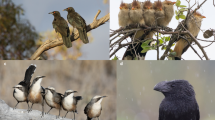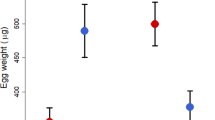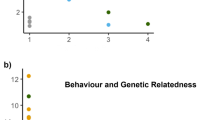Abstract
Animals living in harsh environments, where temperatures are hot and rainfall is unpredictable, are more likely to breed in cooperative groups. As a result, harsh environmental conditions have been accepted as a key factor explaining the evolution of cooperation. However, this is based on evidence that has not investigated the order of evolutionary events, so the inferred causality could be incorrect. We resolved this problem using phylogenetic analyses of 4,707 bird species and found that causation was in the opposite direction to that previously assumed. Rather than harsh environments favouring cooperation, cooperative breeding has facilitated the colonization of harsh environments. Cooperative breeding was, in fact, more likely to evolve from ancestors occupying relatively cool environmental niches with predictable rainfall, which had low levels of polyandry and hence high within-group relatedness. We also found that polyandry increased after cooperative breeders invaded harsh environments, suggesting that when helpers have limited options to breed independently, polyandry no longer destabilizes cooperation. This provides an explanation for the puzzling cases of polyandrous cooperative breeding birds. More generally, this illustrates how cooperation can play a key role in invading ecological niches, a pattern observed across all levels of biological organization from cells to animal societies.
This is a preview of subscription content, access via your institution
Access options
Access Nature and 54 other Nature Portfolio journals
Get Nature+, our best-value online-access subscription
$29.99 / 30 days
cancel any time
Subscribe to this journal
Receive 12 digital issues and online access to articles
$119.00 per year
only $9.92 per issue
Buy this article
- Purchase on Springer Link
- Instant access to full article PDF
Prices may be subject to local taxes which are calculated during checkout





Similar content being viewed by others
References
Wilson, E. O. The Insect Societies (Cambridge Univ. Press, 1971).
Jetz, W. & Rubenstein, D. R. Environmental uncertainty and the global biogeography of cooperative breeding in birds. Curr. Biol. 21, 72–78 (2011).
Koenig, W. D. & Dickinson, J. L. Cooperative Breeding in Vertebrates (Cambridge Univ. Press, 2016).
Rubenstein, D. R. & Lovette, I. J. Temporal environmental variability drives the evolution of cooperative breeding in birds. Curr. Biol. 17, 1414–1419 (2007).
Emlen, S. T. The evolution of helping. I. An ecological constraints model. Am. Nat. 119, 29–39 (1982).
Arnold, K. E. & Owens, I. P. F. Cooperative breeding in birds: the role of ecology. Behav. Ecol. 10, 465–471 (1999).
Pen, I. & Weissing, F. J. Towards a unified theory of cooperative breeding: the role of ecology and life history re-examined. Proc. R. Soc. Lond. B 267, 2411–2418 (2000).
Mcleod, D. V & Wild, G. The relationship between ecology and the optimal helping strategy in cooperative breeders. J. Theor. Biol. 354, 25–34 (2014).
Covas, R., Du Plessis, M. A. & Doutrelant, C. Helpers in colonial cooperatively breeding sociable weavers Philetairus socius contribute to buffer the effects of adverse breeding conditions. Behav. Ecol. Sociobiol. 63, 103–112 (2008).
Rubenstein, D. R. Spatiotemporal environmental variation, risk aversion, and the evolution of cooperative breeding as a bet-hedging strategy. Proc. Natl Acad. Sci. USA 108, 10816–10822 (2011).
Hatchwell, B. J. & Komdeur, J. Ecological constraints, life history traits and the evolution of cooperative breeding. Anim. Behav. 59, 1079–1086 (2000).
Pruett-Jones, S. G. & Lewis, M. J. Sex ratio and habitat limitation promote delayed dispersal in superb fairy-wrens. Nature 348, 541–542 (1990).
Komdeur, J. Importance of habitat saturation and territory quality for evolution of cooperative breeding in the Seychelles warbler. Nature 358, 493–495 (1992).
Bergmüller, R., Heg, D. & Taborsky, M. Helpers in a cooperatively breeding cichlid stay and pay or disperse and breed, depending on ecological constraints. Proc. R. Soc. Lond. B 272, 325–331 (2005).
Dillard, J. R. & Westneat, D. F. Disentangling the Correlated Evolution of Monogamy and Cooperation. Trends Ecol. Evol. 31, 503–513 (2016).
Botero, C. A. & Rubenstein, D. R. Fluctuating environments, sexual selection and the evolution of flexible mate choice in birds. PLoS One 7, e32311 (2012).
Culina, A., Radersma, R. & Sheldon, B. C. Trading up: The fitness consequences of divorce in monogamous birds. Biol. Rev. 90, 1015–1034 (2015).
Hamilton, W. D. The genetical evolution of social behaviour. I & II. J. Theor. Biol. 7, 1–16 (1964).
Maynard-Smith, J. Group Selection and Kin Selection. Nature 201, 1145–1147 (1964).
Garamszegi, L. Z. Modern Phylogenetic Comparative Methods and Their Application in Evolutionary Biology (Springer, 2014).
Colwell, R. K., Ecology, S., Summer, N. L. & Colwell, R. K. Predictability, constancy, and contingency of periodic phenomena. Ecology 55, 1148–1153 (1974).
Botero, C. A., Dor, R., McCain, C. M. & Safran, R. J. Environmental harshness is positively correlated with intraspecific divergence in mammals and birds. Mol. Ecol. 23, 259–268 (2014).
Hughes, W. O. H., Oldroyd, B. P., Beekman, M. & Ratnieks, F. L. W. Ancestral monogamy shows kin selection is key to the evolution of eusociality. Science 320, 1213–1216 (2008).
Lukas, D. & Clutton-Brock, T. Cooperative breeding and monogamy in mammalian societies. Proc. R. Soc. Lond. B 279, 2151–2156 (2012).
Cornwallis, C. K., West, S. A., Davis, K. E. & Griffin, A. S. Promiscuity and the evolutionary transition to complex societies. Nature 466, 969–972 (2010).
Boomsma, J. J. Kin selection versus sexual selection: why the ends do not meet. Curr. Biol. 17, 673–683 (2007).
Hall-Stoodley, L., Costerton, J. W. & Stoodley, P. Bacterial biofilms: from the natural environment to infectious diseases. Nat. Rev. Microbiol. 2, 95–108 (2004).
Maynard-Smith, J. & Szathmary, E. The Major Transitions in Evolution (Oxford Univ. Press, 1995).
Bourke, A. F. G. Principles of Social Evolution (Oxford Univ. Press, 2011).
Duffy, J. E. & Macdonald, K. S. Kin structure, ecology and the evolution of social organization in shrimp: a comparative analysis. Proc. R. Soc. Lond. B 277, 575–584 (2010).
Sun, S. J. et al. Climate-mediated cooperation promotes niche expansion in burying beetles. eLife 2014, 1–15 (2014).
Archibald, J. One Plus One Equals One: Symbiosis and the Evolution of Complex Life (Oxford Univ. Press, 2014).
Cockburn, A. Prevalence of different modes of parental care in birds. Proc. R. Soc. Lond. B 273, 1375–1383 (2006).
Riehl, C. Evolutionary routes to non-kin cooperative breeding in birds. Proc. R. Soc. Lond. B 280, 1830–1833 (2013).
Downing, P. A., Cornwallis, C. K., Griffin, A. S. & Griffin, A. S. Sex. long life and the evolutionary transition to cooperative breeding in birds. Proc. R. Soc. Lond. B 282, 1–7 (2015).
Griffith, S. C., Owens, I. P. F. & Thuman, K. A. Extra pair paternity in birds: a review of interspecific variation and adaptive function. Mol. Ecol. 11, 2195–2212 (2002).
Spottiswoode, C. & Møller, A. P. Extrapair paternity, migration, and breeding synchrony in birds. Behav. Ecol. 15, 41–57 (2004).
Harris, I., Jones, P. D., Osborn, T. J. & Lister, D. H. Updated high-resolution grids of monthly climatic observations – the CRU TS3.10 Dataset. Int. J. Climatol. 34, 623–642 (2014).
Jetz, W., Thomas, G. H., Joy, J. B., Hartmann, K. & Mooers, A. O. The global diversity of birds in space and time. Nature 491, 444–448 (2012).
Drummond, A. J., Suchard, M. A., Xie, D. & Rambaut, A. Bayesian phylogenetics with BEAUti and the BEAST 1.7. Mol. Biol. Evol. 29, 1969–1973 (2012).
R Development Core Team R: A Language and Environment for Statistical Computing (R Foundation for Statistical Computing, 2015).
Hadfield, J. D. MCMC methods for multi-response generalized linear mixed models: the MCMCglmm R package. J. Stat. Softw. 33, 1–22 (2010).
Warnes, G. R. & Burrows, R. Warnes and Raftery’s MCGibbsit MCMC diagnostic (2013); https://cran.r-project.org/web/packages/mcgibbsit/
Plummer, M., Best, N., Cowles, K. & Vines, K. CODA: convergence diagnosis and output analysis for MCMC. R News 6, 7–11 (2006).
Gelman, A. & Rubin, D. B. Inference from iterative simulation using multiple sequences. Stat. Sci. 7, 457–511 (1992).
de Villemereuil, P., Gimenez, O. & Doligez, B. Comparing parent-offspring regression with frequentist and Bayesian animal models to estimate heritability in wild populations: a simulation study for Gaussian and binary traits. Methods Ecol. Evol. 4, 260–275 (2013).
Pagel, M. & Meade, A. Bayesian analysis of correlated evolution of discrete characters by reversible-jump Markov chain Monte Carlo. Am. Nat. 167, 808–825 (2006).
Ives, A. R. & Garland, T. J. in Modern Phylogenetic Comparative Methods and Their Application in Evolutionary Biology (ed. Garamszegi, L. Z. ) 231–262 (Springer, 2014).
Hardenberg, A. von & Gonzalez-Voyer, A. Disentangling evolutionary cause-effect relationships with phylogenetic confirmatory path analysis. Evolution 67, 378–387 (2013).
Orme, C. D. L. et al. CAPER: Comparative Analyses of Phylogenetics and Evolution in R. Methods Ecol. Evol. 3, 145–151 (2012).
Shipley, B. Cause and Correlation in Biology: A User’s Guide to Path Analysis, Structural Equations and Causal Inference (Cambridge Univ. Press 2002).
Koenker, R. Quantile Regression in R: a Vignette (2015); https://cran.r-project.org/web/packages/quantreg/vignettes/rq.pdf
Acknowledgements
We thank the Swedish Research Council (VR), the Knut and Alice Wallenberg foundation, the Royal Society, the US National Science Foundation (IOS-1121435, IOS-1257530 and IOS-1439985) and the European Research Council for funding, and S.-F. Shen for comments.
Author information
Authors and Affiliations
Contributions
C.K.C., S.A., D.R.R. and A.S.G. conceived the study, C.K.C. analysed the data, C.A.B. and P.D. contributed materials, and all authors contributed substantially to writing the paper.
Corresponding author
Ethics declarations
Competing interests
The authors declare no competing financial interests.
Supplementary information
Supplementary Information
Supplementary Figures 1, 2 (PDF 435 kb)
Supplementary Code
Supplementary R code (TXT 42 kb)
Supplementary Tables
Supplementary Tables 1–14 (XLSX 630 kb)
Rights and permissions
About this article
Cite this article
Cornwallis, C., Botero, C., Rubenstein, D. et al. Cooperation facilitates the colonization of harsh environments. Nat Ecol Evol 1, 0057 (2017). https://doi.org/10.1038/s41559-016-0057
Received:
Accepted:
Published:
DOI: https://doi.org/10.1038/s41559-016-0057
This article is cited by
-
Investment by maternal grandmother buffers children against the impacts of adverse early life experiences
Scientific Reports (2024)
-
Cryptic kin discrimination during communal lactation in mice favours cooperation between relatives
Communications Biology (2023)
-
Testing the environmental buffering hypothesis of cooperative breeding in the Seychelles warbler
acta ethologica (2023)
-
Higher temperature extremes exacerbate negative disease effects in a social mammal
Nature Climate Change (2022)
-
Ten recent insights for our understanding of cooperation
Nature Ecology & Evolution (2021)



